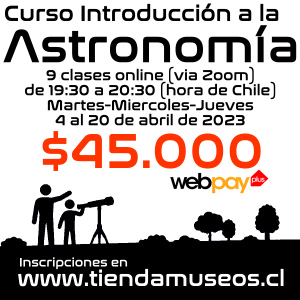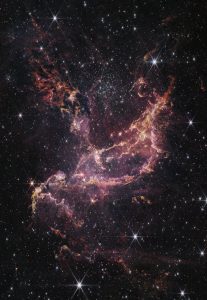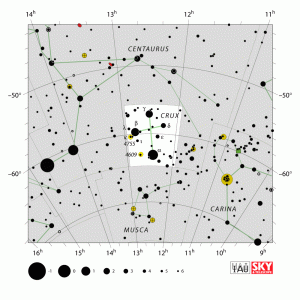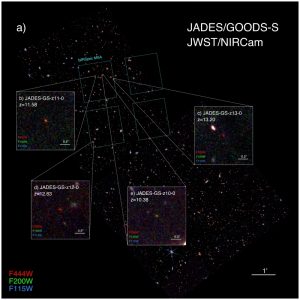El turbulento entorno de un vivero estelar en Orión

The lives of newborn stars are tempestuous, as this image of the Herbig–Haro objects HH 1 and HH 2 from the NASA/ESA Hubble Space Telescope depicts. Both objects are in the constellation Orion and lie around 1250 light-years from Earth. HH 1 is the luminous cloud above the bright star in the upper right of this image, and HH 2 is the cloud in the bottom left. While both Herbig–Haro objects are visible, the young star system responsible for their creation is lurking out of sight, swaddled in the thick clouds of dust at the centre of this image. However, an outflow of gas from one of these stars can be seen streaming out from the central dark cloud as a bright jet. Meanwhile, the bright star between that jet and the HH 1 cloud was once thought to be the source of these jets, but it is now known to be an unrelated double star that formed nearby. Herbig–Haro objects are glowing clumps found around some newborn stars, and are created when jets of gas thrown outwards from these young stars collide with surrounding gas and dust at incredibly high speeds. In 2002 Hubble observations revealed that parts of HH 1 are moving at more than 400 kilometres per second! This scene from a turbulent stellar nursery was captured with Hubble’s Wide Field Camera 3 using 11 different filters at infrared, visible, and ultraviolet wavelengths. Each of these filters is sensitive to just a small slice of the electromagnetic spectrum, and they allow astronomers to pinpoint interesting processes that emit light at specific wavelengths. In the case of HH 1/2, two groups of astronomers requested Hubble observations for two different studies. The first delved into the structure and motion of the Herbig–Haro objects visible in this image, giving astronomers a better understanding of the physical processes occurring when outflows from young stars collide with surrounding gas and dust. The second study instead investigated the outflows themselves to lay the groundwork for future observations
La vida de las estrellas recién nacidas es tempestuosa, como muestra esta imagen de los objetos Herbig-Haro HH 1 y HH 2 del Telescopio Espacial Hubble de la NASA/ESA. Ambos objetos se encuentran en la constelación de Orión y se encuentran a unos 1.250 años luz de la Tierra. HH 1 es la nube luminosa sobre la estrella brillante en la parte superior derecha de esta imagen, y HH 2 es la nube en la parte inferior izquierda. Si bien ambos objetos Herbig-Haro son visibles, el joven sistema estelar responsable de su creación acecha fuera de la vista, envuelto en las espesas nubes de polvo en el centro de esta imagen. Sin embargo, una eyección de gas de una de estas estrellas sale de la nube oscura central y es visible como un chorro brillante. Los astrónomos alguna vez pensaron que la estrella brillante entre ese chorro y la nube HH 1 era la fuente de estos chorros, pero es una estrella doble no relacionada que se formó cerca.

Los objetos Herbig-Haro son grupos brillantes que se encuentran alrededor de algunas estrellas recién nacidas. Se forman cuando los chorros de gas lanzados hacia afuera desde estas estrellas jóvenes chocan con el gas y el polvo circundantes a velocidades increíblemente altas. En 2002, las observaciones del Hubble revelaron que partes de HH 1 se mueven a más de 248 millas (400 kilómetros) por segundo.
La Wide Field Camera 3 de Hubble capturó este turbulento vivero estelar utilizando 11 filtros diferentes en longitudes de onda infrarroja, visible y ultravioleta. Cada uno de estos filtros es sensible a solo una pequeña porción del espectro electromagnético y permiten a los astrónomos identificar procesos interesantes que emiten luz en longitudes de onda específicas.
En el caso de HH 1 y 2, dos grupos de astrónomos solicitaron observaciones al Hubble para dos estudios diferentes. El primero profundizó en la estructura y el movimiento de los objetos Herbig-Haro visibles en esta imagen, brindando a los astrónomos una mejor comprensión de los procesos físicos que ocurren cuando los flujos de salida de las estrellas jóvenes chocan con el gas y el polvo circundantes. El segundo estudio investigó los flujos de salida en sí mismos para sentar las bases para futuras observaciones con el Telescopio Espacial James Webb de la NASA/ESA/CSA. Webb, con su capacidad para mirar más allá de las nubes de polvo que envuelven a las estrellas jóvenes, se espera revolucionará el estudio de los flujos de eyección de las estrellas jóvenes.
Fuente NASA






